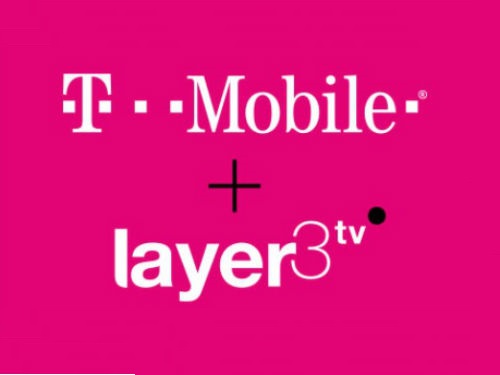T-Mobile Keeps Video Plans Close to the Vest

T-Mobile’s acquisition of Layer3 TV left some analysts and industry observers scratching their heads about the strategy behind it.
RELATED: Media’s Latest Head-Scratcher
That head-scratching is likely to be continuing today as T-Mobile execs didn’t shed much more detail about its grand plans for the Denver-based MVPD during T-Mobile's Q4 2017 earnings call.
T-Mobile did restate that the plan is generally centered on disruptive OTT TV offerings that will launch later this year.
“This move represents a progression in our video strategy,” John Legere, T-Mobile’s CEO, said, noting that Layer3 TV will help to strengthen and expand on other recent video-facing initiatives such as Binge On and the Netflix On Us promotion.
He did stress that the acquisition of Layer3 TV, a deal valued at about $325 million, is about adding the company’s management and talent, technology and content relationships in a way that “will enable us to bring the Uncarrier philosophy to video.”
RELATED: T-Mobile Paid $325 Million for Layer3 TV
Multichannel Newsletter
The smarter way to stay on top of the multichannel video marketplace. Sign up below.
Mike Sievert, T-Mobile’s chief operating officer, said the company isn’t ready to reveal all its plans for Layer3 TV, but acknowledged it will involve establishing a stronger connection between the mobile and TV worlds as traditional MVPDs continue to see their pay TV sub bases erode.
“The eyeballs are moving to phones for a reason, because everything is more engaging in a mobile- and a social-fueled world,” Sievert said. “Young people don't hate 4K panels with HDR video quality. What they hate is what's being served up to them on those panels and how antiquated it is and how non-engaging it is compared to the highly targeted social- and mobile-fueled content that they can get on their phones. We're excited about bringing those worlds together.”
“We continue to believe that content is moving to the internet, and the internet is going mobile, creating multiple opportunities for T-Mobile to continue disrupting the existing landscape,” Legere said.
During the call, T-Mobile was also pressed on why it needs to have its own aggregation service, rather than remaining more of a neutral player.
“I would say that, as of now, we are playing Switzerland,” Legere, said. “We haven’t completely announced what it is we’re going to do [with Layer3 TV].”
He added that T-Mobile likewise hasn’t ruled out anything it will do with video content.
Pricing and packaging details are still to come, but the company apparently has a name for the service in mind, referring to it as “T-Mobile TV” in this updated investor factbook for Q4 and full-year 2017 (pdf).
Mocking Cable’s Mobile Moves
Though T-Mobile is playing coy with its video strategy, execs had some choice words for the threat posed by Comcast and other cable operators that have entered, or are planning to enter, the mobile service market.
Using its MVNO deal with Verizon, Comcast added 187,000 Xfinity Mobile customers lines in Q4, ending 2017 with more than 380,000 (Xfinity Mobile also generated a $480 million EBIDTA loss in 2017). Charter Communications will also be using an MVNO deal with Verizon to launch a mobile offering later this year.
“It’s very irrelevant, and I assume that Charter will be irrelevant-squared,” Legere said, confident that cable’s moves won’t affect T-Mobile’s subscriber guidance (it expects postpaid net adds of between 2 million and 3 million in 2018). “The furthest thing from my mind is any concern about the impact of cable.”
He said T-Mobile also has no fear of cable’s “inside-out-strategy” with mobile and wireless – namely focusing on wireless in homes and offices and eventually expanding that access outdoors.
“It sounds like being sheltered inside your house with a WiFi connection, looking out at the gigantic United States and saying, 'Hey, we're going to go cover that next,’” Legere said. “I’d rather be outside looking in.”
Legere is also amused by Charter’s use of “6G” as a tongue-in-cheek label for its plans to integrate small cell architectures using unlicensed and licensed spectrum with its DOCSIS 3.1 rollout
“6G was the best thing I’ve ever heard,” he said. “The only thing I’m shocked at is that Sprint didn’t announce 7G.”
On M&A: ‘Nothing’s Off the Table’
Legere also would not rule out anything when it comes to M&A activity that could reshape the U.S. mobile industry.
RELATED: Sprint, T-Mobile Scrap Merger Talks
“Nothing’s off the table,” Legere said, noting that the extension on the proposed AT&T-Time Warner deal “put everything on hold for a while.”
“My belief is there’s a huge, pent-up bubble of larger…things that need to happen for customers to be served,” he added.
He touched on several potential scenarios, suggesting that the pace at which things are moving are accelerating behind the scenes.
“Is there a possibility in the future that T-Mobile could do something with Dish, or Sprint or US Cellular? Yes,” he said. “Is there a possibility that a Comcast or Charter could do something with us or around us? Yes. Will I believe that some of that will happen? I believe all of that will happen."
